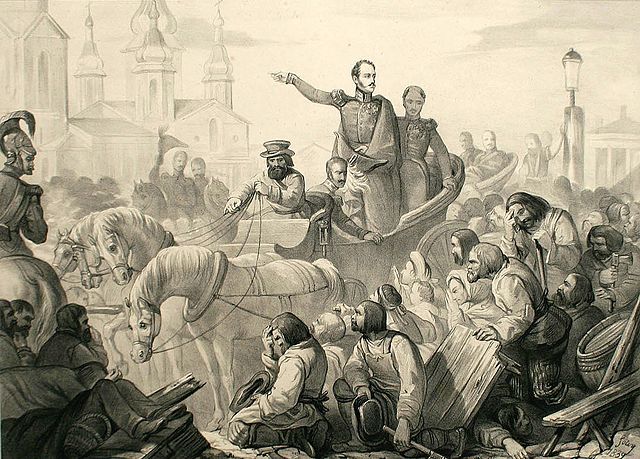 |
| Nicholas 1 confronts rioters during the Cholera Epidemic of 1830-31 |
As seems appropriate in these times of pandemic, I am currently researching the cholera epidemic that hit Russia in 1830 to 1831. The reason for my interest is that my new work in progress, The Legacy, is set in these years, and therefore the impact of the disease can’t be ignored.
In the early 19th century the causes of cholera were unknown and the manner of its transmission contested. This meant that many of the measures adopted by the authorities and remedies suggested by doctors were inconsistent and often useless. The general populace viewed the activities of the authorities at best with suspicion and at worst with violence. Often the rules and regulations that were introduced were seen as evidence of conspiracy on the part of bureaucrats or the police. In the worst cases officials were said to be poisoning wells, using the epidemic as an excuse to settle old scores by getting rid of undesirables, and even to be encouraging the disease as a means of reducing overcrowded areas of the cities. Doctors were accused of wanting people to die so that they could get hold of their corpses for medical experimentation.
Intriguingly the rapid way in which cholera affected the afflicted bore many of the same symptoms of poisoning, a fact that led people to be suspicious that murderers were operating unobserved.
Russia was the first European country to be affected by cholera. The disease spread up the rivers in the east of the country, reaching Moscow in the Autumn of 1830 and spreading north and east, finally arriving in St Petersburg in the summer of 1831.
In general the response of the Russian authorities to the epidemic was heavy handed. The Tsar, Nicholas 1st ‘s first response on the arrival of the disease was to send the army out to defeat it. Unsurprisingly the army had difficulty in finding the enemy! Later responses were more effective but paid little attention to local needs and circumstances
In the face of cholera, few countries in Europe avoided civil disturbance and Russia was no exception, In June 1831 a riot broke out in St Petersburg on Sennaya Square. Nicholas appeared on the streets in person in an attempt to restore order, an initiative which, in the event, proved successful. There were also riots in Sebastopol and in military settlements in the Novgorod area, where a number of army officers were massacred by their troops and local peasants. These incidents were suppressed with brutality.
In the words of Christopher Hamlin , the author of Cholera, The Biography, the disease was ‘brash, bad and coming to get you’. The panic caused by its arrival was, in part, due to the fact that the mortality rate was very high, falling between 40% to over 60% of those afflicted. It was certainly an illness that was best avoided.
Many of the characters in The Legacy will find themselves in St Petersburg at the time in question, facing the threat of the disease, unable to get through the quarantine barriers to the relative safety of the countryside. Some, I suspect, might succumb.
